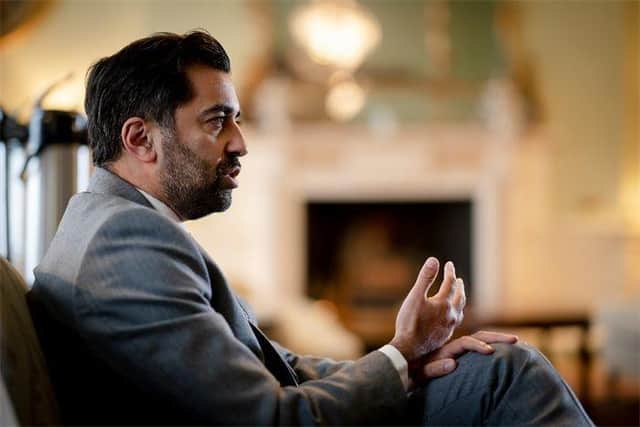Council tax freeze Scotland: The economic realities of Humza Yousaf's SNP conference pledges
These are invariably hastily made, not very well researched, populist sops for a short term – as in tomorrow’s – headline.
Humza Yousaf’s speech, with its multiple such pledges, was a textbook example. To be fair, he did at least have the excuse of having to react to the SNP’s drubbing in the Rutherglen and Hamilton-West by-election only a few days previously.
Starting with the council tax freeze pledge.
Advertisement
Hide AdAdvertisement
Hide Ad

This unilateral decision was taken even though it is opposed by the SNP’s partners in government, the Greens, and in direct contravention of the recent Verity House Agreement, where local government was promised a greater say in its own finances.
It is also regressive in nature, that is it is more beneficial to wealthy households than to poor ones.
The cost to the Government for this policy to be ‘fully funded’ for councils, as is claimed, is unclear.
Does it fully cover recent inflation rates or inflation plus some real terms increase on top? What is inflation anyway?
It could mean anything between 3 per cent and 9 per cent, depending on your approach.
Initial estimates by the Fraser of Allander and the Institute of Fiscal Studies (IFS) put the ‘fully funded’ cost at somewhere between £220 million and £420m.
And what happens after that? A two-year jump up in council tax to to take into account the missing year?
But fear not, apparently the SNP are still “committed to fundamentally reforming local taxation” and have been since 2007, which just happens to be the halfway point between the date of the last valuations, 1991, and the present day. Go figure.
Advertisement
Hide AdAdvertisement
Hide AdNext, we have the NHS pledge of £100m a year for the next three years.
This is a drop in the ocean, around half of a percentage point of Scotland’s Health budget for 2023/24.
The chair of the British Medical Association Scotland, Dr Iain Kennedy, said: “Any initiative to tackle waiting lists is simply not worth the paper it is written on if whole system workforce planning is not right at its heart.”
This will take a lot more than £100m.
On the same day the First Minister spoke, the IFS published its Green Budget report including what the implications were of the published (English) NHS workforce plan.
This aims to increase the number of staff employed by the English NHS from around 1.5 million in 2021/22 to nearly 2.4 million in 2036/37, which implies annual NHS budget increases of around 3.6 per cent per year in real (i.e. after adjusting for inflation) terms.
This suggests that Scotland will get a lot more money for the NHS via Barnett consequentials – the above figures indicate that in any one year this could be worth an extra £1 billion, in cash terms – and it is this money that will ultimately address the NHS staffing issue in Scotland, rather than last Tuesday’s tweak.
In passing, it would be good to have a Scottish NHS workforce plan, which might look legitimately different to the English one, but don’t hold your breath.
And all of the above comes without any estimate of what the extra cost of the bigger, better, Scottish National Care Service might eventually be.
Advertisement
Hide AdAdvertisement
Hide AdThird is Scotland’s first ever bond issue, in order to help fund future infrastructure projects.
Here is an idea that’s just waiting to be kicked into the long grass further down the track, especially as the power to do so has been available since 2015.
Furthermore, according to most analysis, the end result is likely to be a more expensive option than continuing to borrow via the UK Government.
So the point being made becomes a political one, but with a fiscal sting attached.
Then there was what was not in Mr Yousaf’s speech.
The supposed top SNP priority of reducing poverty, especially child poverty, barely got a mention and when it did it was backwards looking, no new money was on the table.
To succeed here will be expensive. If extra money is available, should it not be directed here first and foremost? More so than to keeping council tax bills down or raising spending on arts and culture?
How about reaching net zero, which was also absent from the speech.
The UK’s National Infrastructure Commission this week calculated the UK Government needed to commit to a sharp increase in public sector investment in infrastructure, to around £30bn a year, which will need to be sustained until 2040 in order to reach net zero by 2050.
If Scotland is more ambitious, even more will be needed.
Advertisement
Hide AdAdvertisement
Hide AdMore money will inevitably come in future years from the UK Government, as current figures beyond 2025/26 are infeasibly tight for a government of any political hue.
But the extent of such top-ups may be disappointing, given that, as director Paul Johnson stated at the launch of the IFS’s Green Budget: “We are in a horrible fiscal bind. The price of our high levels of indebtedness, failure to stimulate growth and high borrowing costs is likely to be a protracted period of high taxes and tight spending.”
Furthermore there is already a £600m odd shortfall in the budget for next year, ready to eat up any extra funds. This didn’t need adding to and to do so was reckless.
Ultimately, if Scotland wants to head off in a different direction, its government needs to acknowledge, and act on, how other countries achieve what the SNP apparently wants to.
That is by having higher taxes across the board, not just on the wealthiest. Until that thistle is grasped, this is all about dancing from one pin head to the next, while the overall budget remains insufficient to meet your ambitions.
Comments
Want to join the conversation? Please or to comment on this article.